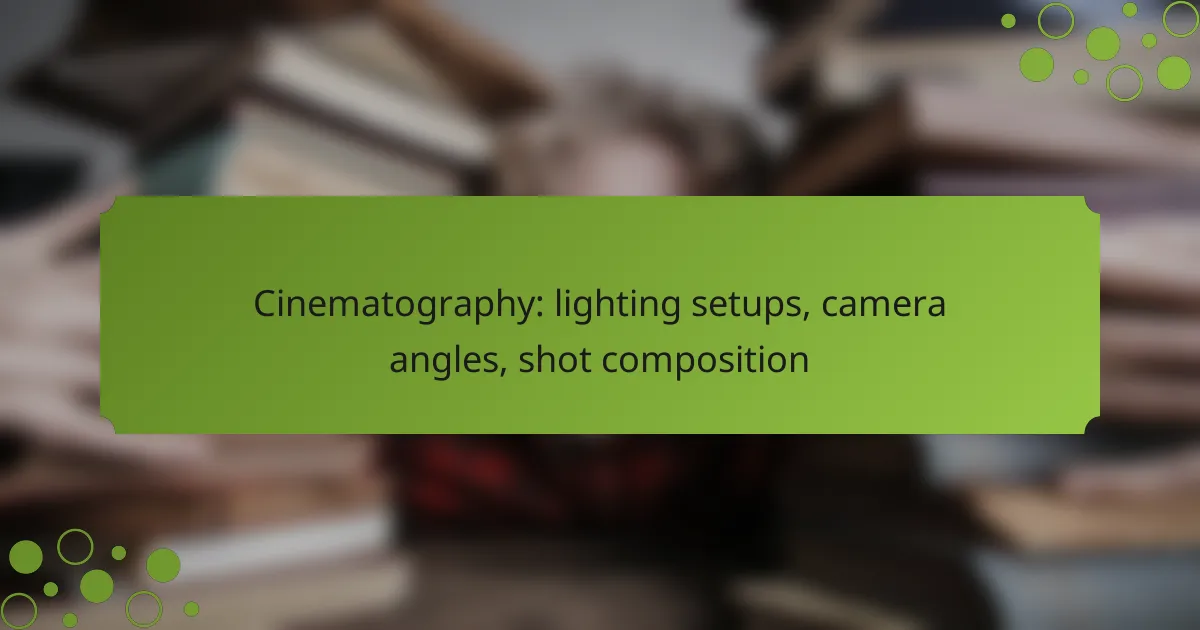Cinematography is a vital aspect of filmmaking that combines lighting setups, camera angles, and shot composition to enhance visual storytelling. Effective lighting creates mood and depth, while strategic camera angles shape audience perception and emotional response. Additionally, thoughtful shot composition arranges visual elements to guide the viewer’s eye and convey meaning, making these techniques essential for impactful narratives.
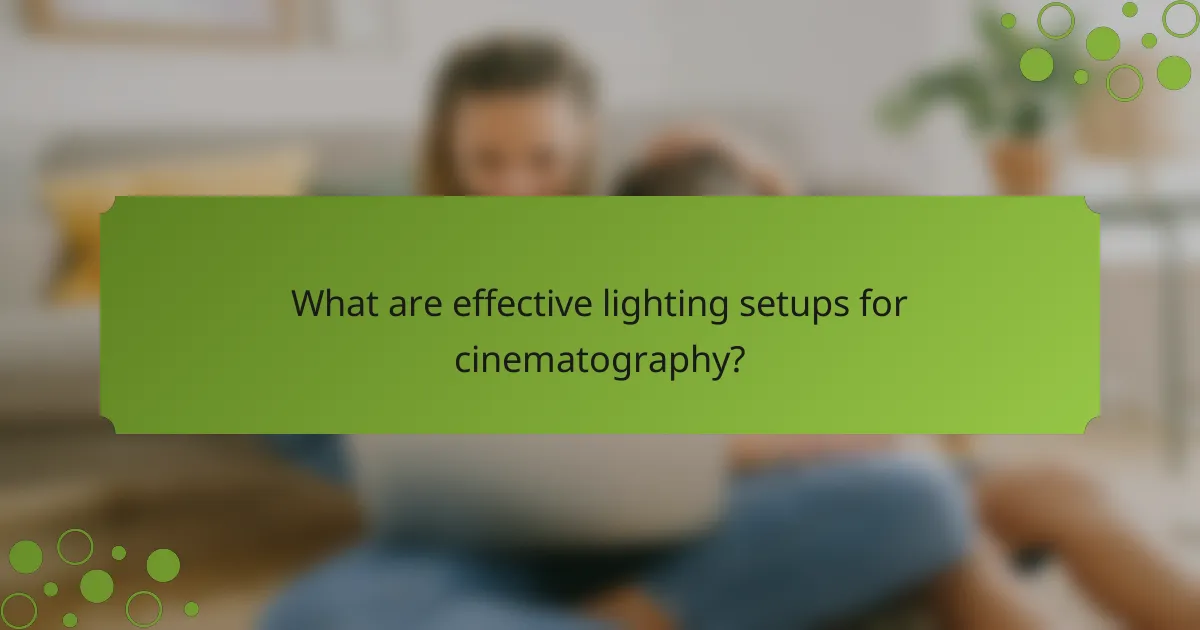
What are effective lighting setups for cinematography?
Effective lighting setups in cinematography enhance the visual storytelling by creating mood, depth, and focus. Key techniques include three-point lighting, natural lighting methods, and various artificial light sources that cater to different scenes and aesthetics.
Three-point lighting
Three-point lighting is a foundational technique that uses three light sources: the key light, fill light, and back light. The key light is the primary source that illuminates the subject, while the fill light softens shadows created by the key light. The back light adds depth by separating the subject from the background.
When setting up three-point lighting, position the key light at a 45-degree angle to the subject, the fill light opposite it at a lower intensity, and the back light behind the subject. This setup creates a balanced and visually appealing look, often used in interviews and narrative scenes.
Natural lighting techniques
Natural lighting techniques utilize sunlight or ambient light sources to illuminate scenes organically. This approach can create a soft, realistic feel, ideal for outdoor shoots or when capturing genuine emotions. Timing is crucial; the golden hour—shortly after sunrise or before sunset—provides warm, flattering light.
To maximize natural light, consider the direction and quality of sunlight. Use reflectors to bounce light onto the subject or diffuse materials to soften harsh sunlight. Be mindful of changing light conditions, which can affect continuity in your shots.
High-key vs low-key lighting
High-key lighting is characterized by bright, even illumination with minimal shadows, often used in comedies or upbeat scenes. This setup typically involves multiple light sources to achieve a soft, cheerful atmosphere. In contrast, low-key lighting creates dramatic contrasts with deep shadows, suitable for thrillers or emotional moments.
To achieve high-key lighting, use a strong key light and fill lights to reduce shadows. For low-key lighting, rely on a single light source and allow shadows to play a significant role in the composition. Understanding the mood you want to convey will guide your choice between these two styles.
LED panel lighting
LED panel lighting has gained popularity due to its versatility and energy efficiency. These panels provide adjustable color temperatures and brightness levels, making them suitable for various shooting conditions. They are lightweight and can be easily mounted or positioned for optimal lighting.
When using LED panels, consider their placement and distance from the subject to avoid harsh lighting. Utilize diffusion materials to soften the light and create a more flattering appearance. Their low heat output allows for prolonged use without discomfort for the talent.
Softbox lighting
Softbox lighting is designed to diffuse light, creating a soft, even illumination that minimizes harsh shadows. This setup is ideal for portrait photography and video interviews, as it flatters the subject’s features. Softboxes come in various sizes, allowing for flexibility in different shooting environments.
To effectively use softbox lighting, position the softbox at a 45-degree angle to the subject and adjust the height to achieve the desired effect. Experiment with the distance between the softbox and the subject to control the softness of the light. Avoid placing the softbox too close, as it may create an overly diffused look.
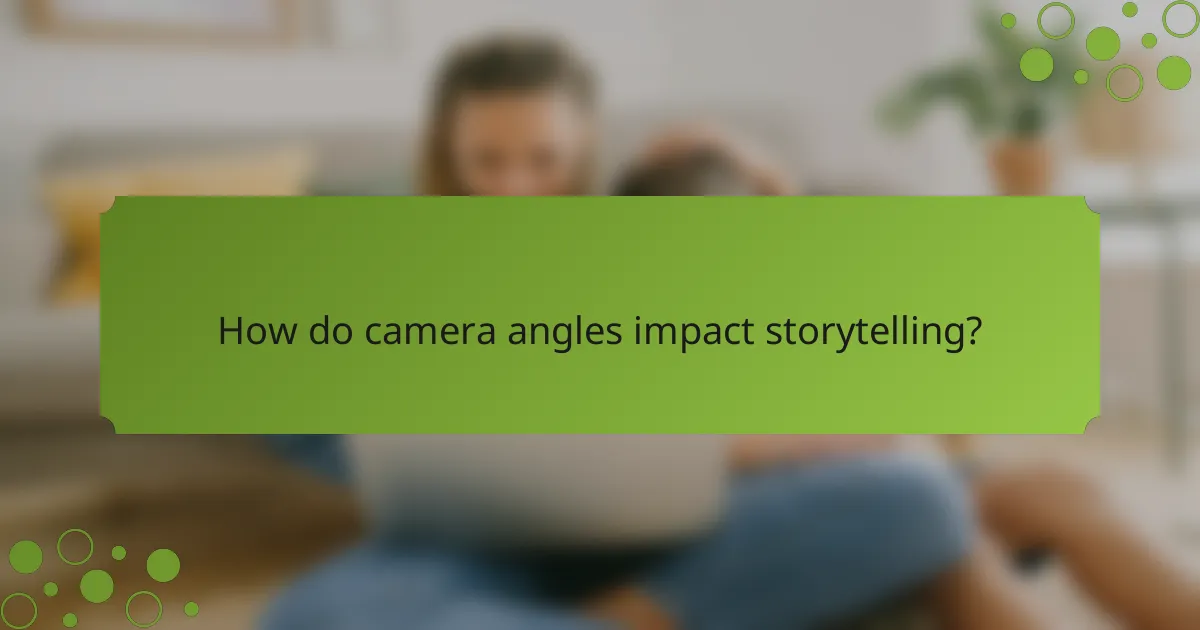
How do camera angles impact storytelling?
Camera angles significantly influence storytelling by shaping how viewers perceive characters and events. Different angles can evoke emotions, establish power dynamics, and guide audience focus, making them essential tools in visual narratives.
High angle shots
High angle shots are taken from above the subject, making them appear smaller or weaker. This perspective can create a sense of vulnerability or inferiority, which is useful in scenes where a character is overwhelmed or in distress.
When using high angle shots, consider the emotional tone you want to convey. For instance, a high angle shot of a protagonist facing a daunting challenge can enhance feelings of helplessness. Use this angle sparingly to maintain its impact.
Low angle shots
Low angle shots are captured from below the subject, making them appear larger and more imposing. This technique can instill a sense of power, authority, or dominance, often used to portray villains or strong leaders.
To effectively utilize low angle shots, position the camera at a height that emphasizes the subject’s stature. This angle can be particularly effective in action sequences or dramatic confrontations, enhancing the viewer’s perception of strength.
Over-the-shoulder shots
Over-the-shoulder shots are framed from behind one character, focusing on another character or object in front. This angle fosters intimacy and connection, often used in dialogue scenes to immerse the audience in the conversation.
When employing over-the-shoulder shots, ensure the foreground character’s shoulder is visible to establish perspective. This technique can enhance tension and engagement, especially during pivotal exchanges between characters.
Bird’s eye view
Bird’s eye view shots are taken directly overhead, providing a unique perspective that can reveal spatial relationships and context. This angle can create a sense of detachment or omniscience, often used in establishing shots to set the scene.
Utilize bird’s eye view shots to showcase large-scale action or to highlight the layout of a location. This perspective can be particularly effective in scenes involving crowds or complex interactions, allowing viewers to grasp the overall dynamics at play.
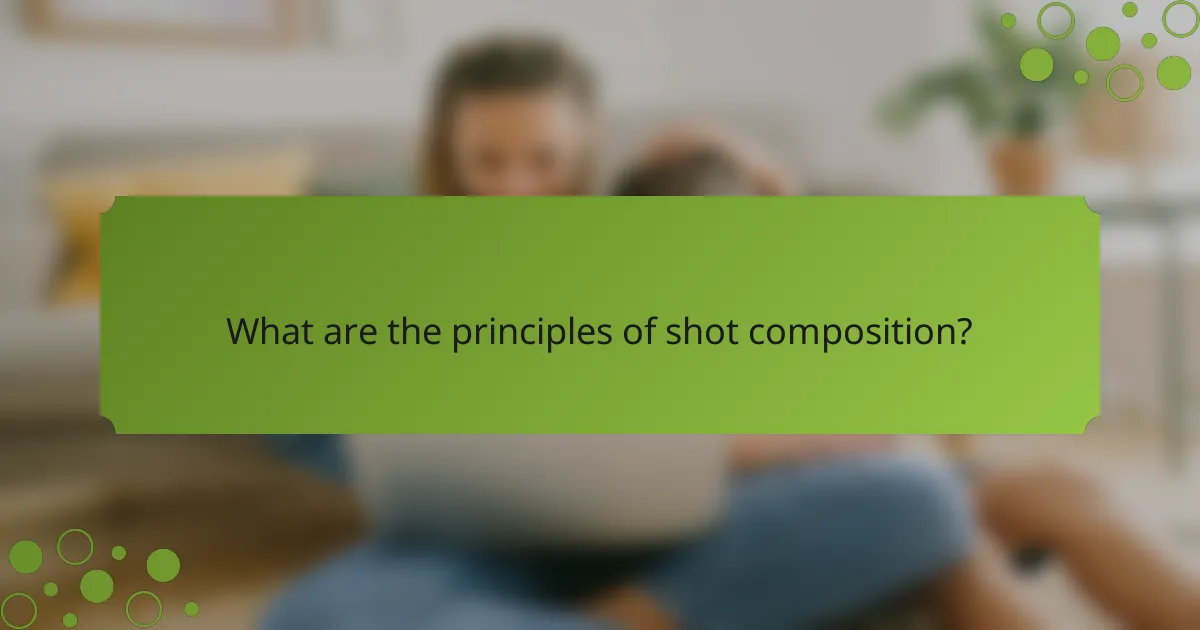
What are the principles of shot composition?
Shot composition involves arranging visual elements within a frame to create a compelling image. Key principles include balance, focus, and the effective use of space to guide the viewer’s eye and convey meaning.
Rule of thirds
The rule of thirds is a fundamental guideline in shot composition that divides the frame into a 3×3 grid. Placing key elements along these lines or at their intersections creates a more balanced and engaging image. For example, positioning a subject’s eyes along the top horizontal line can draw viewers in more effectively than centering the subject.
To apply this rule, visualize the grid while framing your shot. Adjust your composition until important elements align with the grid lines or intersections, enhancing visual interest and dynamism.
Leading lines
Leading lines are natural lines within a scene that direct the viewer’s attention toward the main subject. These can be roads, pathways, or even light beams that create a sense of depth and perspective. Using leading lines effectively can help guide the viewer’s eye through the composition, making the image more engaging.
When incorporating leading lines, consider their direction and strength. Strong, clear lines can create a powerful sense of movement, while subtle lines may offer a more gentle guidance. Experiment with angles to find the most effective way to utilize these lines in your shots.
Framing techniques
Framing techniques involve using elements within the scene to create a “frame” around the subject, drawing attention and adding context. This can include natural elements like trees or architectural features like doorways. Effective framing can enhance the subject’s prominence and create a sense of depth.
When using framing techniques, look for elements that can enclose your subject without overwhelming it. Ensure that the frame complements the overall composition and enhances the viewer’s focus on the main subject.
Depth of field
Depth of field refers to the range of distance within a shot that appears acceptably sharp. A shallow depth of field isolates the subject by blurring the background, while a deep depth of field keeps more of the scene in focus. Choosing the right depth of field can significantly impact the mood and clarity of your shot.
To control depth of field, adjust your aperture settings. A wide aperture (low f-stop number) results in a shallow depth of field, ideal for portraits, while a narrow aperture (high f-stop number) is suitable for landscapes. Consider the story you want to tell when deciding on the depth of field for your shot.
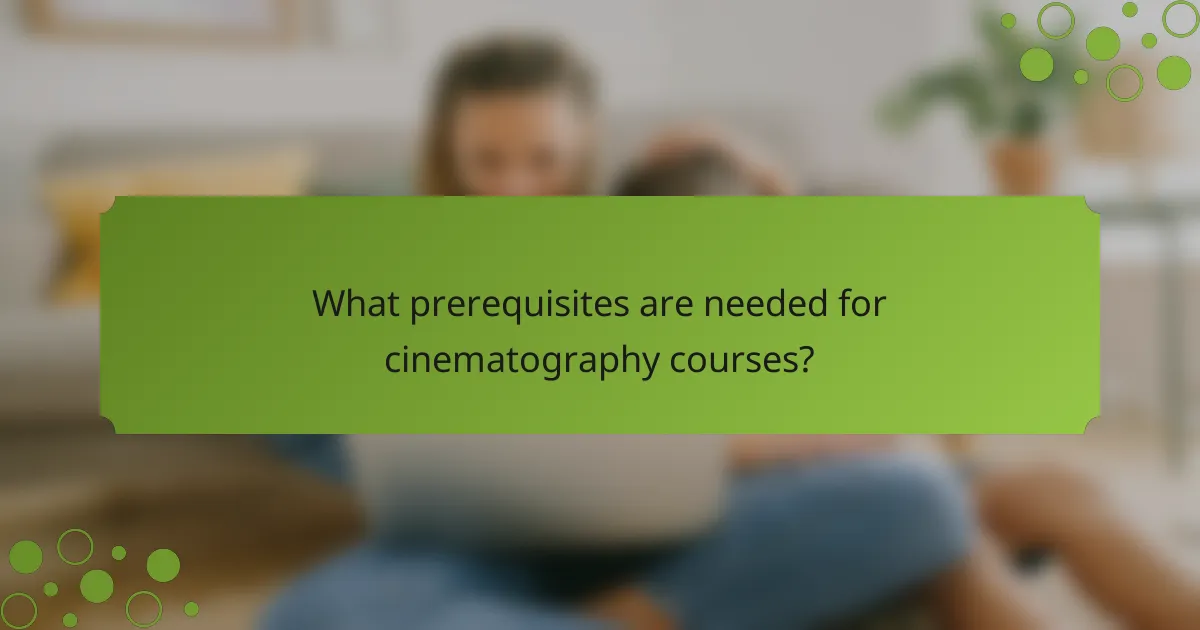
What prerequisites are needed for cinematography courses?
To enroll in cinematography courses, students typically need a foundational understanding of photography and film theory. These prerequisites ensure that learners can effectively engage with the technical and artistic aspects of cinematography.
Basic photography knowledge
A strong grasp of basic photography principles is essential for cinematography. This includes understanding exposure, composition, and lighting. Familiarity with camera settings such as aperture, shutter speed, and ISO will help students manipulate images effectively.
Students should practice taking photos in various lighting conditions to develop their skills. Experimenting with different angles and compositions can also enhance their visual storytelling abilities. Resources like online tutorials or local photography clubs can provide valuable hands-on experience.
Understanding of film theory
Film theory provides the conceptual framework for cinematography. It covers narrative structure, visual storytelling, and the emotional impact of camera angles and shot composition. A solid understanding of these elements allows cinematographers to make informed creative choices.
Students should explore key concepts such as mise-en-scène, shot types, and editing techniques. Reading foundational texts or watching classic films with a critical eye can deepen their appreciation for how cinematography influences storytelling. Engaging in discussions or workshops can further solidify this knowledge.
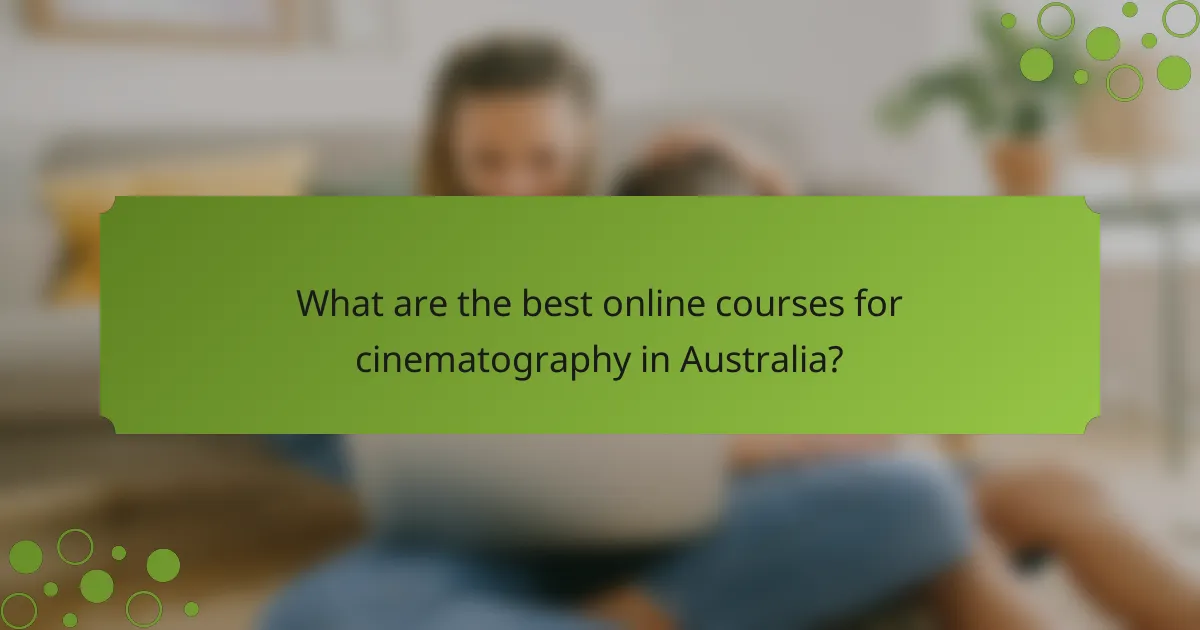
What are the best online courses for cinematography in Australia?
The best online courses for cinematography in Australia focus on practical skills in lighting setups, camera angles, and shot composition. These courses often combine video lectures, hands-on assignments, and community feedback to enhance learning.
Top Online Platforms for Cinematography Courses
Several platforms offer excellent cinematography courses tailored for Australian students. Websites like Udemy, Coursera, and MasterClass provide a range of options from beginner to advanced levels. Each platform typically features user reviews, course outlines, and instructor credentials to help you choose the right fit.
Key Course Features to Consider
When selecting a cinematography course, look for features such as practical assignments, access to industry-standard software, and opportunities for peer interaction. Courses that include feedback from experienced professionals can significantly enhance your learning experience. Additionally, consider the course duration and whether it fits your schedule.
Cost and Accessibility
Online cinematography courses in Australia can vary in price, typically ranging from AUD 50 to several hundred dollars. Many platforms offer financial aid or payment plans to make courses more accessible. Ensure that the course you choose is compatible with your learning style and offers flexible access to materials.
